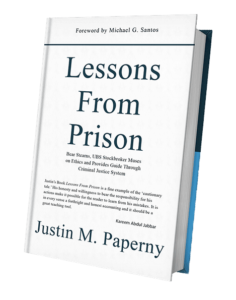HOW MUCH PRISON TIME WILL ELIZABETH HOLMES GET?
PART 1
Introduction
A person’s possible federal prison time begins with the US Sentencing Guidelines, but it does not end there. The guidelines provide a baseline for the sentencing judge, but they are not mandatory.
Judge Edward Davila has full discretion to consider the guidelines and other factors in handing down Holmes’ final sentencing outcome.
See below for more information about Sentencing
Everyone has views on Elizabeth Holmes’ sentencing. Some people argue for a prison sentence on the lighter side because of the many other Silicon Valley CEOs never prosecuted for similar conduct.
Others argue for life in prison because of the brazen fraud and the staggering amount of money Holmes raised for Theranos.
The truth is somewhere in between.
Holmes was found guilty of four counts: one count of conspiracy, and three counts of wire fraud under 18 US Code Section 1343. In this blog series, we walk through the Sentencing Guidelines calculations for Elizabeth Holmes and attempt to predict her possible sentence.
What are the US Sentencing Guidelines?
Federal judges consult the Sentencing Guidelines as a starting point to determine what may be a fair and consistent sentencing range in a case. The Sentencing Guidelines take into account the seriousness of the criminal conduct and the defendant’s criminal record.
If you have views or a prediction about Holmes’ prison sentence, leave us a comment below.
Discussion
Holmes’ sentencing hearing will be on September 26, 2022, if all goes according to current plans.
A lot will happen in the case between now and then, including events related to Holmes’ sentencing hearing.
Upcoming Events
For example, at some point in the 90 days preceding the sentencing hearing, Elizabeth Holmes will sit for an extensive interview with the US Probation Office, which is part of the pre-sentence investigation process. At the end of the presentence investigation, a US Probation Officer will submit a Pre-Sentence Report (PSR) to her sentencing judge, Judge Edward Davila. Usually, a person is not sentenced without a PSR in the federal system.
Before her sentencing hearing, Holmes’ legal team will prepare a pre-sentence memorandum arguing for leniency for Holmes, while prosecutors will also prepare the government’s presentence memo.
Watch our video discussing Elizabeth Holmes’ anticipated probation interview See Below:
This summer, there will be post-trial motions, including a motion for a new trial. Judge Davila scheduled a hearing for June 16 to consider Holmes’ requests to reverse her convictions and a new trial.
In March, Theranos COO Sunny Balwani’s trial is on the calendar.
Finally, Holmes is likely to file a notice of appeal challenging her conviction and sentence at some point.
The Process For Calculating an Advisory Prison Term Under the Sentencing Guidelines
To delve into Holmes’ sentencing guidelines calculations, we can use the United States Sentencing Commission Worksheet for Individual Offenders, accessible here:
The Sentencing Guidelines Table or Chart needed to fill out the Worksheet is available here:
The Worksheet and Table are the same ones that a US Probation Officer will use when preparing Holmes’ presentence investigation report or (PSR).
Attorneys for each side will receive the Probation Officer’s draft report, including a preliminary evaluation of the sentencing guidelines calculation.
Lawyers for both sides get a preview of the report and the guidelines calculation from the Probation Officer in time to seek amendments before the final draft goes to the court. Lawyers for both sides can also file objections to the PSR.
Step 1: Sentencing Guidelines Base Offense Level
The first step in making a sentencing guidelines calculation for a federal offender begins with the Base Offense Level. The sentencing guidelines provide 43 levels of offense seriousness — the more serious the crime, the higher the base offense level.
Note: Under the US Sentencing Guidelines, each type of crime is assigned a base offense level. This is the starting point for determining the seriousness level of a particular offense. More serious types of crime have higher base offense levels (for example, a trespass has a base offense level of 4, while kidnapping has a base offense level of 32).
Holmes is convicted of 3 wire fraud counts and one conspiracy to commit wire fraud count. When wire fraud carries a sentence of up to 20 years, the base offense level is 7.
Step 2: Sentencing Guidelines Specific Characteristics of the Offense
In addition to the base offense level, each offense type typically has a number of specific characteristics or factors that vary from offense to offense. These factors can increase or decrease the base offense level.
Such specific characteristics in Holmes’ case include
- loss amount;
- number of victims;
- whether financial harm occurred to more than 5 or 25 people; and
- risk of substantial bodily harm.
Let’s look at each in turn.
Loss Amount. In financial crimes, the loss amount – which is simply the amount of loss involved in the offense – is an important specific offense characteristic.
The loss amount on the 4 wire fraud counts for which Holmes stands convicted total about $144 million. Based on a loss greater than $65 million but less than $150 million, the sentencing guidelines add 24 levels to the base offense level of 7.
Adding 7 and 24 yields 31, which translates to a suggested prison sentence range of 108–135 months (9-11 years).
Some observers propose a harsher approach, arguing that for sentencing purposes, Holmes’ loss amount should be $950 million, or the total amount of money Elizabeth Holmes raised for Theranos based on technology that did not work. If the loss amount is more than $500 million, the guidelines add 30 points to the base offense level.
Adding 7 and 30 yields a score of 37, which translates to a suggested prison sentence range of 210–262 months (17-20+ years).
*Note: Where the suggested Guidelines range is greater than 20 years, note that the wire fraud statute under which Holmes was convicted caps her maximum sentence at 20 years.
Federal sentencing judges have broad discretion at sentencing. And the difference between going with a loss amount of $144 million or $950 million is massive.
Still, going with a loss amount of $950 million would be tricky because that number includes losses as to which the jury did not find that Holmes was guilty. Expect prosecutors and defense lawyers to argue about whether Holmes should be sentenced based on an amount of more than $500 million or not.
The number of victims. Another specific characteristic considered in financial crimes is the number of victims, and the worksheet asks whether the number of victims is 10 or more. Where the number of victims is 10 or more, the guidelines add 2 more points.
Of course, most of the victims in Holmes’ case are corporate entities, as opposed to individual people. Taking just the investors in the 3 counts of conviction, there would be less than 10 victims.
Substantial financial hardship to 5 or more/25 or more people. Also, if substantial financial harm occurred to more than five people, the guidelines suggest an additional 4 points. If substantial financial harm occurred to more than 25 people, the guidelines suggest an additional 6 points.
There will be an argument as to whether the sophisticated investors involved in Holmes’ case suffered financial hardship or not. Venture capital firms are professional investors who understand the risks they are getting into, as opposed to mom and pop investors.
If you have views about whether these financial hardship points should be added to Holmes’ score, share them in the comments.
Risk of serious bodily harm. Another specific offense characteristic the guidelines consider is the risk of serious bodily harm.
The government sought to convict Holmes for defrauding Theranos patients and lost. That may not preclude prosecutors from arguing that by promoting blood testing technology that did not work Holmes put people’s lives at risk.
Also, sentencing judges can consider the defendant’s conduct other than purely criminal conduct.
The defense team will argue that this is a financial case and additional points based on the risk of serious bodily harm to patients are not warranted when the jury acquitted her on all of the counts involving patients.
If you have views about whether these risk of bodily harm points should be added to Holmes’ score, share them in the comments.
Step 3: Conspiracy to Commit Wire Fraud
Holmes has 3 wire fraud counts of conviction and one conspiracy to commit wire fraud count of conviction.
The calculation for the conspiracy count is the same as the 3 wire fraud counts. The guidelines provide that conspiracy counts should be grouped with the substantive counts of conviction.
Step 4: Consecutive or Concurrent?
Another step is to determine whether the sentences imposed for each count of conviction will run consecutively (back to back) or concurrently (at the same time).
The sentencing guidelines indicate that if the counts of conviction are part of the same course of conduct or a continuation of a particular criminal scheme or enterprise, then those are grouped together for sentencing purposes.
Therefore, should Holmes get 8 years, for example, the time will cover all of the 4 counts of conviction.
A concurrent sentence will allow Holmes to serve all of her sentences at the same time.
Step 5: Specific Characteristics of the Offender
Among other factors the sentencing guidelines consider are those specific to the offender and their conduct.
In this part of the calculation, the guidelines consider, among other things, whether the defendant:
- played a leadership/organizer role;
- exploited vulnerable victims;
- abused special skills or abused a position of trust; or
- committed obstruction of justice.
Let’s look at each of these in turn, as they apply to Elizabeth Holmes.
Leadership Role/Organizer: A person’s role in a fraud or financial scheme matters. This gets at whether Holmes had a leadership role, and organized the scheme.
As founder and CEO, it is hard not to agree that Holmes played a leadership role and was an organizer of the scheme.
The guidelines suggest 4 additional points based on a leadership role.
The only arguments we have heard that her team might use here would be the Svengali defense-–that Holmes was under the manipulation and control of her boyfriend Sunny Balwani and therefore should not be penalized with these 4 additional points.
*Note: In court, the Svengali defense portrays the defendant as a pawn in the scheme of a very influential criminal mastermind.
Even though the jury did not adopt the Svengali defense to acquit Holmes, her team can still use the argument at sentencing.
Let us know in the comments below your views about Holmes’ Svengali defense.
Vulnerable Victims. Here, the guidelines consider whether or not the defendant knew that the victims were particularly vulnerable. In Holmes’ case, this factor again raises the issue of the sophisticated, professional Theranos investors, who had the means to conduct their own due diligence.
Because Holmes was convicted on counts dealing with professional investors, she has a good chance to avoid a vulnerable victim enhancement. The guidelines suggest an additional 2 points when there is a vulnerable victim.
Prosecutors may try to resuscitate the point that patients were in a vulnerable position vis–vis Theranos, and their vulnerability should count.
The judge will decide then whether that is the sort of vulnerability that this section of the guidelines targets.
Abuse of Trust or Special Skills. Where lawyers, doctors, brokers, and other offenders who occupy a position of trust abuse their positions, or where people with special skills abuse them in a criminal scheme – the Guidelines suggest a 2 point add to the person’s score.
The argument against Holmes here is that she was the founder and inventor of the blood-testing technology she peddled, and, as such, she was in a unique position to fool others.
If you think Holmes abused special skills to commit fraud, let us know in the comments.
Obstruction of Justice. Another section of the guidelines looks to enhance the sentence calculation of a person who tries to obstruct justice. Here, the guidelines call for 2 levels added for obstruction of justice.
Obstruction of justice enhancements can occur when people destroy evidence, commit perjury, or engage in witness intimidation.
Prosecutors may argue that a database of test results that might have been unfavorable to Holmes was mysteriously deleted during the criminal investigation.
We also know that Holmes (and her partner Sunny Balwani) tried to intimidate any employees and former employees who talked about what was going on inside Theranos, including whistleblowers Erica Cheung and Tyler Schultz.
However, the defense has good arguments against sentencing enhancements for witness intimidation. Theranos used heavy-handed tactics to avoid people talking to the media, but also used legal counsel to deal with suspected whistleblowers. Holmes never personally stopped anyone from going to law enforcement.
CONCLUSION
The US Probation Officer conducting Elizabeth Holmes’ presentence investigation will produce a report for the sentencing judge, Judge Davila. The report, called the PSR, includes the officer’s methodical calculation of a recommended sentence under the Sentencing Guidelines. That calculation will be merely advisory, not mandatory.
Both sides will have the opportunity to object to the Probation Officer’s sentence calculation, and Judge Davia will resolve those objections before sentencing Elizabeth Holmes.
Follow our 3-part series on How Much Prison Time Will Elizabeth Holmes at www.prisonprofessors.com.
In Part 2, we finish looking at the sentencing factors that apply to Elizabeth Holmes and predict a possible sentence range.




